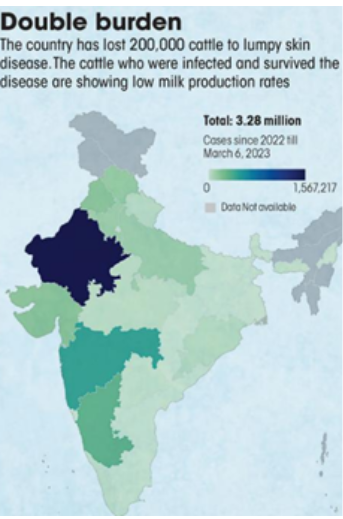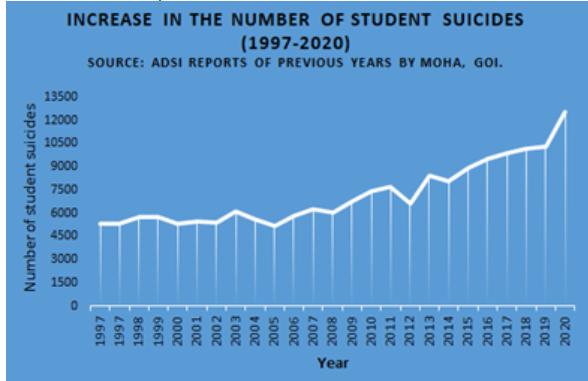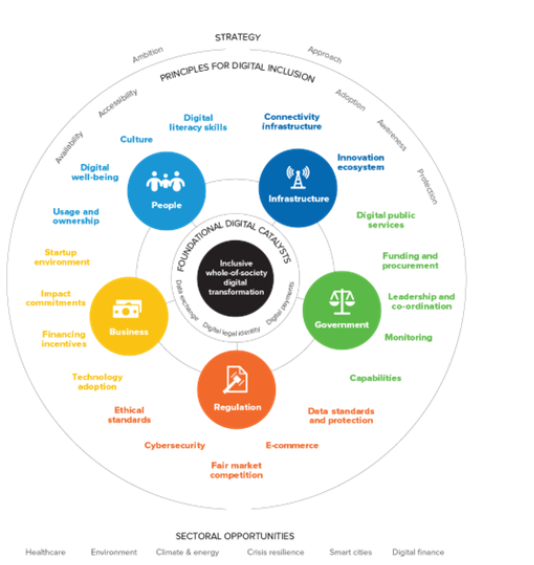Friday, 29th September 2023
India Elderly to Make Up 20% of Population by 2050-UNFPA Report
In News: According to United Nations Population Fund’s, “2023 India Ageing Report”, the percentage of elderly population in the country is projected to double to over 20% of total population by 2050 with a “predominance of widowed and highly dependent very old women”.
About the UNFPA report:
- United Nations Population Fund (UNFPA) is a UN agency dedicated to enhancing global reproductive and maternal health. It published a report “2023 India Ageing Report” projecting India's age composition in coming decades.
- The report used data from the 2011 Census, the 2017-18 Longitudinal Ageing Survey in India, population projections of the Government of India and World Population Projection 2022 report
- The report can be used as an important resource for scholars, policymakers, program managers, and all stakeholders involved in elder care.
Key Findings of the Report:
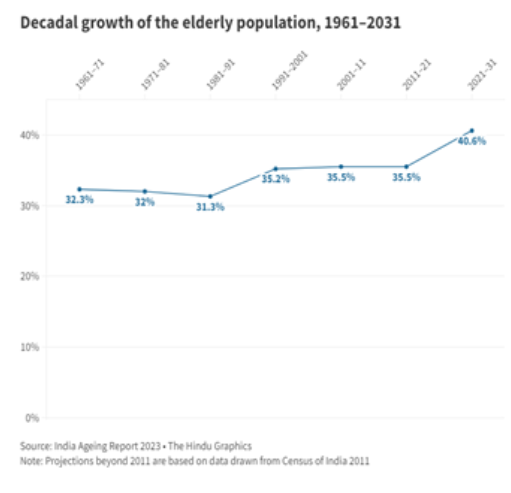
- Doubling of the elderly population: The decadal growth rate of the elderly population of India is currently 41%. Thus elderly population is projected to double to over 20% of the total population by 2050.
- Elderly to surpass Children population: It is being estimated that by 2046 elderly population will have surpassed the population of children (aged 0 to 15 years) in the country.
- Poverty among elderly: More than 40% of the elderly in India are in the poorest wealth quintile, with about 18.7% of them living without an income which affects their quality of life and healthcare utilization.
- Increase in the 80+ population is projected to grow at a rate of around 279% between 2022 and 2050 with a “predominance of widowed and highly dependent very old women”.
- Higher life expectancy of Women: Women, on average, had higher life expectancy at the age of 60 and at 80, when compared to men.
- Regional variation: Life expectancy of women and sex ratio among elderly varies across states and Union Territories.
- Life expectancy of women at 60 years is greater than 20 years in States such as Rajasthan, Haryana, Gujarat, Uttarakhand, Kerala, Himachal Pradesh etc. raising concerns about their social and economic well-being,
- Sex ratio among the elderly has been climbing steadily since 1991, with the ratio in the general population stagnating. In Central India, sex ratio (>60 years population) went from 973 in 2011 to 1,053 in 2021.
- Old-age dependency ratio i.e. elderly people per 100 people between 15 and 59 years, was higher in Southern India, than the national average at around 20 as is true of Western India at 17.
Implication of aging population:

- Increased pressure on social security systems: The elderly population is more likely to be dependent on social security systems, such as pensions and healthcare.
- Increased burden on families: The elderly population is more likely to live with their families, which can put a strain on financial and emotional resources.
- Decreased workforce participation: The ageing population will lead to a decrease in the workforce participation rate.
- Increased healthcare costs: The elderly population is more likely to need healthcare, which can increase healthcare costs.
- Inherently gendered poverty: Poverty is inherently gendered in old age when older women are more likely to be widowed, living alone, with no income, and with fewer assets of their own.
- Feminisation and Ruralisation of older population
- , and policies must be framed accordingly; data show that women, on an average, have a higher life expectancy at the age of 60 and 80 when compared with men.
Recommendation of the report:
- Focus on elderly in disaster-preparedness plans: Elderlies received inadequate support from the government during COVID-19. Public healthcare facilities were not accessible and nobody except NGOs or community-based organisations helped them. Thus policies and plans are required to focus on the needs of the elderly.
- Collection of credible data related to the elderly in India could be done by including questions on relevant issues related to older persons in the upcoming National Sample Survey, the National Family Health Survey, and the Census of India.
- Increasing awareness about government schemes: The report suggested that the government must work on increasing awareness about schemes for older persons, bring all Old Age Homes under regulatory purview, and focus on facilitating in-situ ageing to the extent possible.
- Promoting elderly self-help groups: Government needs to encourage the creation and running of elderly SGHs, and promote elderly people living in multigenerational households.
- Promote in situ aging: Government should encourage in situ (at home) ageing by creating short-term care facilities like creches or day-care facilities.
Source: India ageing, elderly to make up 20% of population by 2050: UNFPA report - The Hindu
Newspapers for handling food - Edukemy Current Affairs
In News: Recently, the Food Safety and Standards Authority of India (FSSAI) has urged consumers and food vendors to stop using newspapers for packing, serving, and storing food due to health hazards.
Harmful impacts of using Newspapers for handling food:
- The Food Safety and Standards (Packaging) Regulations, 2018, restrict the use of newspapers or similar materials for food storage or packaging.
- Newspapers' ink contains bioactive substances that can contaminate food and be hazardous to human health.
- Additionally, pollutants like mineral oils and chemicals may be present in recycled paper boxes, which might lead to harmful effects and digestive issues.
- Chemicals from printing inks, such as lead and heavy metals, have been shown to contaminate food.
- During distribution, newspapers are exposed to a variety of environmental factors, rendering them vulnerable to bacterial or virus contamination.
- When consumed, contaminants from newspapers can cause foodborne diseases. Food packaged in such materials puts vulnerable populations, such as the elderly and those with compromised immune systems, at higher risk of developing cancer-related health problems.
Food Safety and Standards Authority of India (FSSAI):
- Food Safety and Standards Authority of India (FSSAI) is an autonomous statutory body established under the Food Safety and Standards Act, 2006 (FSS Act).
- It comes under the Ministry of Health & Family Welfare, Government of India.
- Headquarters: Delhi.
- Key functions of FSSAI:
- Set standards for food products
- Develop safe food practices
- License food businesses
- Ensure compliance through inspections
- Test food for standards
- Train and build capacity
- Citizens Outreach
- Structure of FSSAI:
- The FSSAI comprises of a Chairperson and twenty-two members out of which one – third are to be women.
- The Chairperson of FSSAI is appointed by the Central Government.
- The Food Authority is assisted by Scientific Committees and Panels in setting standards and the Central Advisory Committee in coordinating with enforcement agencies.
- The primary responsibility for enforcement is largely with the State Food Safety Commissioners.
- Challenges with FSSAI:
- The “petty manufacturers, retailers and hawkers” are exempted from FSSAI ambit.
- Lack of infrastructure such as food testing laboratories.
- Shortage of qualified manpower and functional food testing equipment in state food laboratories and referral laboratories resulted in deficient testing of food samples.
- Acute shortage of licensing and enforcement officers in the states.
- The body has been only prescriptive in nature and failed to ensure safety, quality and hygiene in food industry.
Pharma-MedTech Sector: R&D & Innovation Policy
Why in News: Recently, the Union Minister of Chemicals and Fertilizers and Minister of Health & Family Welfare in India, has launched the National Policy on Research and Development and Innovation in the Pharma-MedTech Sector.
About the Policy:
- The Policy will help to create an ecosystem of skills and capacities including the academia and the private sectors, and give impetus to new talent among the youth through start-ups.
- The Scheme will focus on transforming India into a high volume, high value player in the global market of pharmaceuticals, meeting the quality, accessibility, and affordability goals.
Benefits of the Scheme:
- Development of research infrastructure- The scheme would help in building a world-class research atmosphere at NIPERs and other institutes and help in creating talent pool of qualified trained students.
- This scheme will promote industry-academia linkages by promoting collaboration between the private sector and govt institutes.
- Focus on certain priority areas which will help India's pharma industry leapfrog and radically strengthen its position in the world market as innovation accounts for 2/3rd of global pharmaceutical opportunities.
- The scheme would help in launching of commercially viable products which will accelerate the growth of the Indian pharmaceutical sector by increased revenue and creating employment opportunities.
- The scheme would help in the development of affordable, accessible solution for primary area of health concern thus reducing healthcare burden.
Export Duty-Tax Remission Scheme: RoDTEP
Why in news? Recently, the government extended export benefits under the RoDTEP scheme for one more year till June 2024.
About:
- The RoDTEP scheme provides exporters with refunds for taxes, duties, and levies incurred during the manufacturing and distribution of goods, which are not reimbursed through other mechanisms at the central, state, or local levels.
- The scheme is operational since September 2021.
- It will help the exporting community to negotiate export contracts in the present international environment on better terms.
- The RoDTEP scheme replaced the Merchandise Exports from India Scheme (MEIS), which concluded the previous year.
- The RoDTEP Committee operates within the Department of Revenue.
- Its primary responsibility is to review and recommend ceiling rates for different export sectors under the RoDTEP Scheme.
Social bonds - Edukemy Current Affairs
Why in news? Recently, The National Bank for Agriculture and Rural Development (Nabard) issued India’s first ‘AAA’ rated Indian Rupee-denominated Social Bonds aggregating ₹1,040.50 crores at a coupon rate of 7.63 percent.
About:
- The social bonds issued by NABARD have received ‘AAA’ ratings from CRISIL and ICRA, and they will be listed on the BSE (Bombay Stock Exchange).
Social bonds
- A social bond is a type of financial instrument issued by governments, international organizations, or corporations to raise funds for projects and initiatives that have a positive social impact on society.
- These bonds are designed to finance projects that address various social issues, such as healthcare, education, affordable housing, poverty alleviation, and environmental sustainability.
Sustainability Bond Framework:
- NABARD recently introduced a Sustainability Bond Framework, aimed at financing and refinancing green and social projects.
- Eligible social projects include affordable basic infrastructure, access to essential services, affordable housing, employment generation, food security, socioeconomic advancement, and empowerment.
PET46 - Edukemy Current Affairs
In News: A recent study involving scientists from Kiel University (Germany) has discovered a deep-sea enzyme, PET46, capable of continuously breaking down PET plastic, commonly found in plastic bottles.
About:
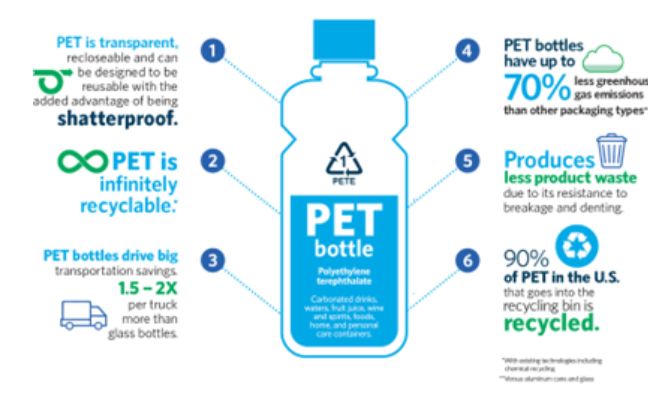
- PET46 has the ability to degrade both very long-chain PET molecules (polymers) and short-chain PET molecules (oligomers), which means that degradation can be continuous.
- It uses a completely different mechanism for substrate binding than previously known PET-degrading enzymes.
- A 'lid' of 45 amino acids above the enzyme's active center is crucial for binding, whereas in other PET enzymes, aromatic amino acids close to the active site are typical.
- This research is part of the PLASTISEA project and sheds light on the potential for plastic waste degradation in the sea and on land.
- The discovery of PET46 has been made from deep-sea organisms belonging to the archaea domain.
- Archaea is a domain of single-celled microbes lacking cell nuclei and are therefore prokaryotes.
PET plastic
- PET plastic, or polyethylene terephthalate, is a common type of plastic used to make bottles, containers, and synthetic fibres.
- It is known for its transparency, lightweight nature, and recyclability.
- PET is widely used for packaging beverages, food, and personal care products.
Esports in Asian Games (Hangzhou)
In News: Recently, League of Legends (LoL), a popular multiplayer online battle arena (MOBA) video game, was one of the seven esports medal events at the Asian Games 2023, held in Hangzhou, the People’s Republic of China.
About:
Asian Games
- The Asian Games is the biggest sports competition in Asia, held once every four years. They are organized by the Olympic Council of Asia (OCA).
- The symbol for the Asian Games is the rising sun with interlocking rings.
- It is recognised by the International Olympic Committee.
Esports
- Esports, short for electronic sports, refers to organized competitive video gaming.
- It involves individuals or teams competing in various video games at a professional level, often in tournaments with significant prizes.
- Esports was previously featured as a demonstration sport at the Jakarta Asian Games (2018) and proved highly popular.
League of Legends
- League of Legends is a 5v5 multiplayer online battle arena game (MOBA) where two teams of five players each battle it out on a quadrangular map.
- The main objective of the game is to destroy the opponent team’s main structure, also called the Nexus, located at the other end of the battlefield.
- Whichever team destroys the opposition’s Nexus first wins.
Types of online gaming:
- E-sports (well-organized electronic sports which include professional players),
- Fantasy sports
- Casual games: these can be either skill-based (mental skill) or chance-based (based on a random activity like a roll of a dice) online games.
https://olympics.com/en/news/asian-games-2023-esports-india-league-of-legends-team-schedule-results
Kaimur Wildlife Sanctuary - Edukemy Current Affairs
In News: Bihar is set to get a second tiger reserve in Kaimur district (Kaimur Wildlife Sanctuary) by the end of 2023 or early 2024.
About:
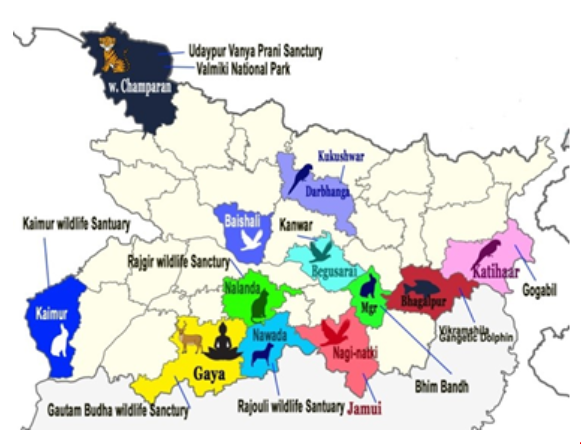
- Kaimur Wildlife Sanctuary, Bihar’s largest, covers Kaimur and Rohtas Districts.
- It was established in 1979.
- It is home to rare and endangered flora and fauna. Rohtasgarh Fort and Shergarh Fort are also located in these forests.
- Kaimur district has a large forest cover and is home to tigers, leopards and chinkaras.
- Vegetation: Tropical Dry Mixed Deciduous, Dry Sal Forests, Boswellia Forests and Dry Bamboo Brakes.
- There are several waterfalls of which the finest are Karkat Waterfall, Manjhar Kund, Dhua Kund.
- There are several Dams and lakes, including Anupam Lake, Karamchat dam and Kohira Dam.
More Information:
- 1st tiger reserve of Bihar:
- The Valmiki Tiger Reserve (VTR) in West Champaran district, is currently the 1st and only tiger reserve of the state.
- Need for the 2nd tiger reserve:
- A report of the NTCA said that the tiger population in the Valmiki reserve has increased from 31 in 2018 to 54.
- The total tiger count in the State currently is 54.
- There is a need for the second tiger reserve in the state as Valmiki TR has reached its saturation point of 50 tigers.
Balsams - Edukemy Current Affairs
In News: Recently, Balsams (genus Impatiens) have been in full bloom in Munnar, Kerala.
About:

- Balsams are sometimes referred to as ‘touch-me-not’ due to their tendency to burst and distribute mature seeds upon touch.
- Balsams refer to plants belonging to the genus Impatiens. These are flowering plants known for their small pink flowers.
- They are locally called as Kasithumba and Onappovu.
- Balsams are considered significant indicator species for climate change, reflecting alterations in plant populations when climate change occurs.
- Found in:
- Of the 220 balsam species in India, 135 are found in the southern Western Ghats.
- Anamudi, the highest mountain in the Western Ghats, and the surrounding high ranges are known for the diversity of wild balsams.
- Idukki district, where Munnar is located, is renowned for its diverse range of balsams, earning it the nickname of a “balsam paradise” among scientists.
- Around 46 species of balsams have been discovered in the altitude of Munnar. No other place in the world has such diversity.
State of Working India (SWI 2023) report
Exam View: State of Working India (SWI 2023) report; The findings; The 2017-2021 period; India’s growth strategy.
Context: A new report is out called the State of Working India (SWI 2023) and it has used official employment and unemployment data to understand how economic growth impacts employment.
Decoding the editorial: State of Working India (SWI 2023) report
- It has been brought out by the Centre for Sustainable Employment within the Azim Premji University (APU).
- The report stands out because APU academics and researchers have used official employment and unemployment data to arrive at the results.
- This is the fourth edition of SWI and it focuses on “a long-run view of India’s structural transformation experience and its implications for three key social identities: caste, gender, and religion”.
- SWI 2023 analyses data from 1983 to 2023 and uses a whole host of official data sources including
- Periodic Labour Force Surveys (PLFS),
- National Family Health Surveys (NFHS),
- Census 2011, and
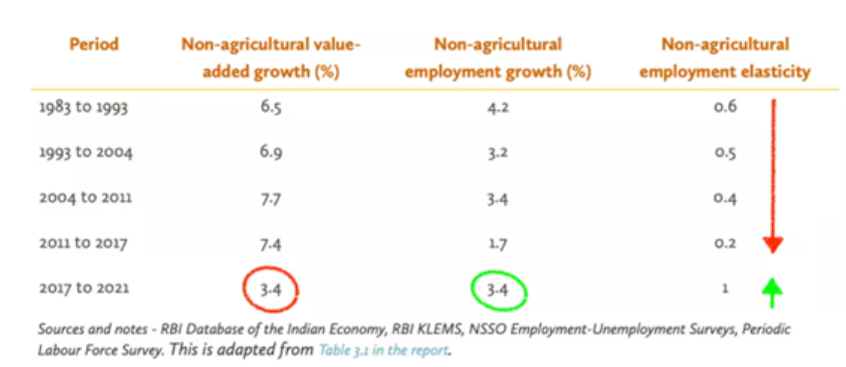
-
- Economic Census 2013.
The findings
- The impact of economic growth on employment in the aggregate.
- A good way to measure this relationship is to look at employment elasticity of growth.
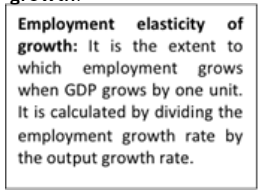
-
- As can be seen in TABLE 1, employment elasticity has consistently fallen between 1983 and 2017, showing that a 1% increase in GDP leads to a less than 1% increase in employment.
- The table shows that since the 1980s, non-farm output, that is GDP from sectors other than agriculture, consistently grew much faster than non-farm employment.
- The impact of economic growth on different segments of the Indian economy.
- As data shows, factors such as caste, religion, age and gender tend to have a considerable impact on how the benefits of growth get distributed in the economy.
- The need to appreciate the quality of the jobs being created.
- For instance, providing “casual labour” at an MGNREGA worksite or a construction worksite or working part-time in one’s family enterprise without any pay (“self-employment”) are very poor substitutes for holding a job that provides a regular wage.
The 2017-2021 period
- The employment elasticity went up sharply during this period. However, this simple observation can be misleading, as observed by APU.
- There has been a fall in output growth.
- The non-farm employment growth rate improved during this period, but
- The non-farm output growth (the denominator in this formula) also fell quite sharply.
- The quality of jobs has fallen.
- When the economy does well and employers find it worthwhile to create new jobs, the kind of jobs that are created are regular wage jobs or, at least, casual labour jobs.
- But instead, what has been created in this phase is self-employment.
- This is the kind of work that pays no regular wage with the remuneration distinctly below other categories of jobs.
- Between 2017 and 2021, there was a slowdown in overall regular wage job creation but formal jobs (with a written contract and benefits) as a share of all regular wage work rose from 25% to 35%.
- In 2020-21 (pandemic year) regular wage employment fell by 2.2 million.
- The biggest losers in the process were the women.
- While half of the lost employment is accounted for by women, only a third of the increase in formal employment accrued to women.
- So in net terms, women lost out on formal employment in this period. Not only that, there was a shift towards self-employment due to distress.
India’s growth strategy
- Different experts have different solutions for India
- Doubling down on boosting labour-intensive manufacturing, even if it is for just domestic consumers.
- Shifting to “green” manufacturing can provide India with an opportunity to redo the industrial revolution.
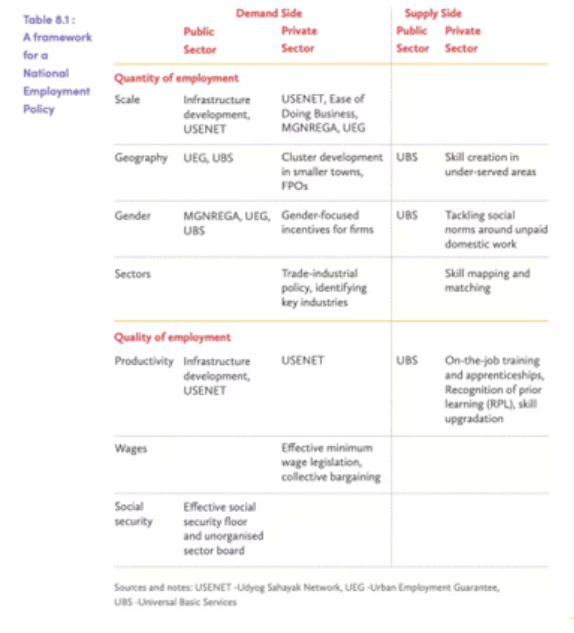
- A framework for a National Employment Policy was outlined in the previous (2021) SWI report.
Share the article
Edukemy’s Current Affairs Quiz is published with multiple choice questions for UPSC exams
MCQ
Get Latest Updates on Offers, Event dates, and free Mentorship sessions.

Get in touch with our Expert Academic Counsellors 👋
FAQs
UPSC Daily Current Affairs focuses on learning current events on a daily basis. An aspirant needs to study regular and updated information about current events, news, and relevant topics that are important for UPSC aspirants. It covers national and international affairs, government policies, socio-economic issues, science and technology advancements, and more.
UPSC Daily Current Affairs provides aspirants with a concise and comprehensive overview of the latest happenings and developments across various fields. It helps aspirants stay updated with current affairs and provides them with valuable insights and analysis, which are essential for answering questions in the UPSC examinations. It enhances their knowledge, analytical skills, and ability to connect current affairs with the UPSC syllabus.
UPSC Daily Current Affairs covers a wide range of topics, including politics, economics, science and technology, environment, social issues, governance, international relations, and more. It offers news summaries, in-depth analyses, editorials, opinion pieces, and relevant study materials. It also provides practice questions and quizzes to help aspirants test their understanding of current affairs.
Edukemy's UPSC Daily Current Affairs can be accessed through:
- UPSC Daily Current Affairs can be accessed through Current Affairs tab at the top of the Main Page of Edukemy.
- Edukemy Mobile app: The Daily Current Affairs can also be access through Edukemy Mobile App.
- Social media: Follow Edukemy’s official social media accounts or pages that provide UPSC Daily Current Affairs updates, including Facebook, Twitter, or Telegram channels.

